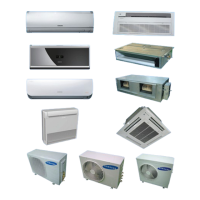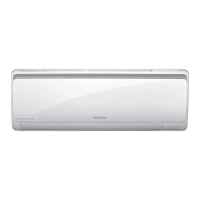What to do if the Timer LED is on but my Samsung MH035FMEA won't turn on?
- JJodi SchwartzAug 12, 2025
The timer is activated, and the unit is in ready mode. Cancel the timer operation for normal operation.
What to do if the Timer LED is on but my Samsung MH035FMEA won't turn on?
The timer is activated, and the unit is in ready mode. Cancel the timer operation for normal operation.
Why doesn't my Samsung MH035FMEA Air Conditioner cool when the room is hotter than the set temperature?
This can happen after a 3-minute delay when the compressor is re-operated, or when power is turned on.
What to do if my Samsung MH035FMEA's compressor stops intermittently in COOL or DRY mode, and the fan speed decreases?
The compressor might be stopping intermittently, or the indoor fan speed might be decreasing, to prevent the inside/outside air from freezing, depending on the inside/outside air temperature.
Why does my Samsung MH035FMEA Air Conditioner's compressor stop intermittently in DRY mode?
In DRY mode, the compressor operation is automatically controlled depending on the room temperature and humidity.
Why does the compressor and indoor fan stop intermittently in HEAT mode on my Samsung Air Conditioner?
To protect the compressor from overheated air in HEAT mode, the compressor and indoor fan will stop intermittently if the room temperature exceeds the set temperature.
Why do the indoor and outdoor fans stop intermittently in HEAT mode on my Samsung Air Conditioner?
In HEAT mode, the compressor operates in a reverse cycle to remove exterior ice. The indoor and outdoor fans do not operate intermittently for within 20% of the total heater operation.
Why is the compressor of the outdoor unit operating when my Samsung MH035FMEA is turned off in HEAT mode?
When the unit is turned off while de-ice is activated, the compressor continues operation for up to 12 minutes (maximum) until the deice is completed.
What to do if my Samsung MH035FMEA Air Conditioner indoor and outdoor units do not operate properly?
Check the terminals to ensure the indoor and outdoor units are properly linked by the same number of cables and that the connecting position on the terminal is correct.
Guidelines and safety measures for installing the air conditioner unit.
Instructions for safe power supply connection and circuit breaker usage.
Detailed technical specifications for various indoor and outdoor units.
Step-by-step guide for disassembling the outdoor unit.
Guide to identifying and checking indoor unit error codes.
Guide to identifying and checking outdoor unit error codes.
Procedure for setting options using the remote control.
Steps for checking and testing the air conditioner after installation.
Common operational errors and their troubleshooting steps.
Troubleshooting specific errors encountered during try-run operation.
Diagnosing faults based on observed symptoms in the air conditioner.
Procedures for checking and testing the outdoor unit controller.
Troubleshooting compressor startup, lock, and rotation errors.
Troubleshooting IPM overcurrent errors in outdoor units.
Procedures for checking temperature sensors in the unit.
Procedure for checking the Electronic Expansion Valve (EEV) step.
Guidelines and procedures for inspecting printed circuit boards (PCBs).
Layout and connection points for indoor unit printed circuit boards.
Layout and connection points for outdoor unit printed circuit boards.
Procedure for connecting the circuit and purging air from the system.
Instructions for refilling refrigerant after installation or leakage.
Procedure for 'pump down' when replacing components or relocating the unit.
Frequently asked questions and answers for common non-trouble issues.
| Cooling Capacity | 3.5 kW |
|---|---|
| Heating Capacity | 4.0 kW |
| Power Supply | 220-240V, 50Hz |
| Refrigerant | R410A |
| Indoor Unit Weight | 9 kg |
| Outdoor Unit Weight | 30 kg |
| Type | Split |
| EER | 3.21 W/W |
| Power Consumption (Cooling) | 1.09 kW |
| Outdoor Unit Noise Level | 50 dB(A) |












